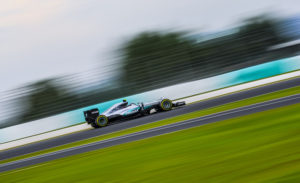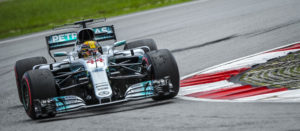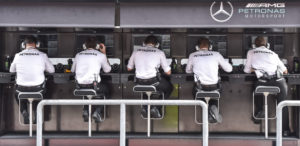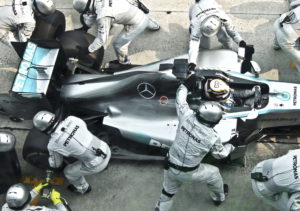
Go Fast and Win: The Big Data Analytics of F1 Racing

(Abdul-Razak-Latif/Shutterstock)
What’s the secret to winning in Formula One racing? Simple: Go faster than everybody else. But finding a lasting recipe for success on the racetrack today requires getting hundreds of variables right, so it’s no wonder that F1 teams are turning to big data analytics for help.
For a case study in how big data analytics is impacting racing, there’s no better example than Mercedes-AMG Petronas Motorsport, which propelled driver Lewis Hamilton to the Formula One driver’s championship in November 2017, and which took home the constructor’s title to boot. It was Hamilton’s fourth F1 title.
Data analytics has become a critical factor in Formula One racing, according to Matt Harris, who heads up IT for Mercedes-AMG Petronas Motorsport’s success.
“It’s difficult, because nobody talks about it too much,” Harris told Datanami during a TIBCO conference in San Diego, California last October. “Everybody knows how important it’s going to be.”
Analytics Arms Race
An F1 Grand Prix is a three-day weekend event that typically includes two days of qualifications followed by a race on Sunday. On Friday, the racecar is loaded with sensors so the team can see what’s working and what’s not. By Saturday, the car is stripped of all but the most critical sensors, and the car racing on Sunday must be identical to the Saturday car.
Getting the car set up for each race is a painstaking process that involves balancing a variety of variables, including: What type of track are they running on? How did the racecar do last year? How much downforce should they shoot for? How much air should go in the tires? How quickly should the transmission shift gears? What’s the weather going to be like? What did the wind tunnel tests show? And how do you expect other teams to configure their racecars?

Lewis Hamilton takes a turn at the Malaysia Grand Prix in September 2017 (Hafiz Johari/Shutterstock)
When you tweak one variable in the configuration, it can have an impact on others, creating a cascading effect that leaves the racecar better or worse off. It’s Harris’ job to use an array of data processing and analysis techniques to position his team to determine which configurations will lead to more favorable outcomes. Which of course is easier said than done.
“Pre and post event, we do thousands of Monte Carlo simulations, the ‘what if’ scenarios on the configuration of the car, what you would do on lap one, two, three, four, five,” he says. “You base that on what you think you would do and what competitors would do based on what you’re learning on a Friday and a Saturday.”
Visualizing Success
On a Friday, a Mercedes team racecar could be equipped with up to 300 sensors that measure all aspects of the car, such as the temperature of the transmission fluid, the state of the engine oil, the pressure and temperature of the tires, the car’s ride height, etc. The number of sensors is paired down on the Saturday and Sunday cars to save weight.
The sensors sample conditions anywhere from a thousand times per second to one second intervals. All told, about 18,000 channels of data are flowing in the Mercedes team’s servers, amounting to about 500GB of data per race weekend, Harris says. Over the course of a season, that translates into about 10TB of data.

Mercedes-AMG Petronas Motorsport crewmembers at the Malaysian Grand Prix in September 2017 (By Hafiz Johari/Shutterstock)
Considering that the team brings the previous season’s data to each race – and sometimes the data from the year before that too – it all adds up to lugging about 30TB of baseline data from race to race around the world – no small feat of its own. When it travels, the team stores data on solid-state PureStorage arrays, which helps to keep weight down and protects the data.
During a weekend race, Mercedes-AMG Petronas Motorsport might have 30 employees analyzing data at the track, while anywhere from 30 to 200 workers are analyzing the data back at racing headquarters. “We’re always producing more and more data,” Harris says. “With the amount of data we’re generating, we’re limited on the number of eyes that can look at data.”
The team has adopted TIBCO’s Spotfire visualization tool to help it analyze racecar data in an effort to find abnormalities that might indicate a problem or to help it confirm its existing race-day strategy. It helps the track-side team to make pre-race changes to configuration, and to inform strategy changes on race day.
“Don’t make people have to look at all 500 GB of data,” Harris says. “Only look at the anomalies. Only look at the differences. Help us to visualize our data so we can make more intelligent decisions quicker and faster, so that you don’t have to sift through data to work out what’s interesting.”
Shifting Gears Analytically
The transmission is a perfect example of how data analytics can help Mercedes-AMG Petronas Motorsport configure a faster racecar on race day, Harris says.
“Every time a driver makes a gear change, we get a few hundred data points,” the Brit says. “If you imagine they make around 100 or so gear changes per lap, you can start to straightaway get into millions of data points right quite easily.”

Nico Rosberg pit stops his Mercedes AMG Petronas F1 racecar during the Malaysian Grand Prix in March 2014 (Shahjehan/Shutterstock)
Harris’ team analyzes every gear change across several variables. It looks at the speed of the shift, the amount of wear on the clutch, the temperature of the oil, and the speed of the engine, among other factors. The team closely watches how much damage the transmission is absorbing, because if it takes too much damage, it will fail before the race is over.
But, on the other hand, you don’t want the driver ending the race with a pristine transmission, so balancing damage with performance is where it gets tricky – and where analytics can provide an advantage. “How quick you want to do the gear change?” Harris asks. “Do you want it to be smoother or do you want it to be quicker? Smoother is obviously better – there’s less wear, but it’s not as fast.”
There are ways to execute a gear change faster, but at the expense of increased wear, Harris says. “You can gain 50 milliseconds per lap,” he says. “To you or me, that’s nothing. But if you consider that the weekend two people in qualifying had the same lap time around Austin to one-one thousandth of a second over a two-mile track, 50ms just got yourself one extra space in the grid.”
Bleeding Edge
In addition to Spotfire, the Mercedes team uses other data analysis tools and techniques, including use of computational fluid dynamic (CFD) simulations to determine the optimal balance between downforce and drag. Downforce is essential for keeping the light racecars glued to the track, but it also causes more drag, which limits how fast the car can go on the straightaways.
Late in the 2017 season, Harris’ team was experimenting with TIBCO’s streaming analytics offering, Streambase, to provide real-time analysis of the transmission. Currently, the transmission data is analyzed after-the-fact. By merging Streambase and Spotfire capabilities, Harris hopes to provide a closer-to-real-time view.
The company is still looking at whether emerging machine learning and deep learning frameworks can help it win more races. “We’ve looked at Caffe 2 and others,” Harris says. “There’s lots of different frameworks, and that’s our problem at the moment.”
We’re three races into the 2018 season, and so far the Mercedes-AMG Petronas Motorsport is struggling a bit. Hamilton hasn’t won a Grand Prix, and the team has blamed the struggles in part on its strategy. There’s lots of racing yet to be done, and you can bet that the team will be looking to analytics to help it get back on track.
“In the beginning of the season, you’re trying to make sure of reliability, because if you don’t have reliability, then performance is useless,” Harris says. “But at the same time, you don’t want to be playing around at the back of the grid, going around slowly, just ’cause you’re nice and reliable.
It’s all about finding the right balance between taking reasonable chances and avoiding unnecessary risk. “As you start getting toward the end of the season, maybe it’s a bit tight in the championship, and all of a sudden, we want to push the boundaries of somethings,” Harris says. “How close do you get to bleeding edge rather than leading edge? Bleeding edge sounds great, but you can get hurt and you can fail.”
Analytics will help the Mercedes team make critical decisions, which the team hopes puts it into a position to win. But ultimately, Harris is pragmatic about the impact that analytics can have. His advice is pertinent to businesses everywhere that are trying to find an edge with analytics.
“You’re only going to be as good as the ideas you come up with and how well you implement them,” he says. “Everybody has a simulator, everybody has CFD, everybody has sensors, everybody has their own toolsets. I don’t think anybody actually is going to be able to steal a match from anybody else very quickly.”
Related Items:
NASCAR Analytics Races To ‘Younger Crowd’
The Big Data Behind Shell’s Super-Efficient Car Races
Data Driving Formula 1 Racing to New Heights




























